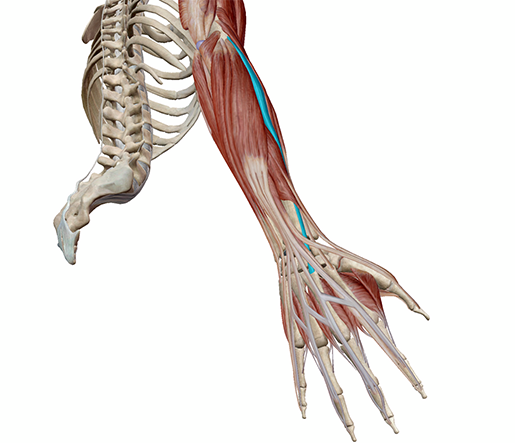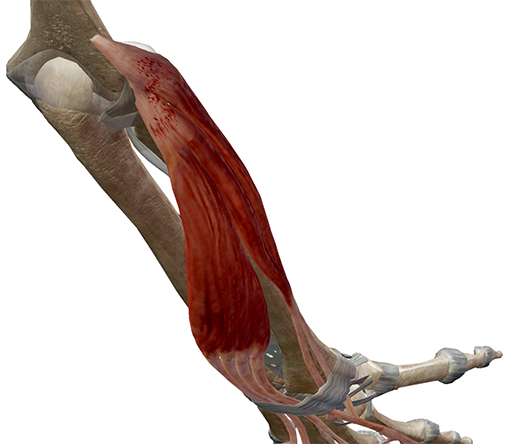Posted on 7/27/17 by Madison Oppenheim
Not all of us can be Serena Williams.
That's what I told myself after my first tennis match, on the drive to McDonald's for consolation ice cream. You see, I really thought I was good at it, but I guess that's what happens when adults think that everyone should be treated as a winner—you have unmistakably high expectations for yourself.
Years later, after overhearing relatives and neighbors complain of "tennis elbow," I'm slightly relieved I didn't try to go for the gold at the US Open.
Want to learn more about sports injuries? Check out our free "Sports Injuries 101" eBook.
Your elbow joint is made up of three main guys: the humerus, the responsible older brother, and the devilish twins, the radius and the ulna. These dudes all work together to give you the ability to do handstands, drive your dad's Subaru, and eat that fifth roll at Bertucci's. There are also muscles, ligaments, and tendons that hold the joint together. Ligaments connect bone to bone, and tendons connect bone to muscle.

Image captured from Human Anatomy Atlas. Pictured: the muscles of the upper limb with the extensor carpi radialis brevis highlighted.
There’s a bony bump on the lateral side of the humerus called the lateral epicondyle, which is where the tendons of the forearm—also called extensors—attach. The common extensor tendon serves as the point of attachment for the upper muscles of the back forearm.
The star of today's show is the extensor carpi radialis brevis, but the extensor carpi radialis longus and the extensor digitorum also play a role.
But I just bought a new racquet! Does this mean I should never play tennis again?
No, of course not, but overuse by repeated contraction of the forearm muscles can lead to tennis elbow, because microtears that can develop in the tendons get inflamed and cause pain.
Don't let the athletes have all the fun! Tennis and other sports aren't the only causes of lateral epicondylitis. Work and other recreational activities can also lead to tennis elbow, as repetitive forearm movements can cause microtears. Studies have shown that carpenters, painters, plumbers, butchers, and even cooks get tennis elbow more frequently than the rest of the population.
Watch out, Bobby Flay!
 Image captured from Muscle Premium. Notice the microtears in the common extensor tendon.
Image captured from Muscle Premium. Notice the microtears in the common extensor tendon.
Some symptoms of lateral epicondylitis include pain on the lateral epicondyle (outer elbow) and having weak grip strength. Pain and weakness may make it difficult to grip objects, turn doorknobs, or hold your morning Starbucks.
Tennis elbow usually affects people ages 30–50 but anyone with other risk factors (i.e., improper stroke technique and equipment in racquet sports) can develop it.
Fun fact: pain worsens with forearm activity! So put down that racquet and go get checked out by your doctor.
There are a variety of treatments for lateral epicondylitis so don't fret.
The first step toward recovery is to rest your arm! I know it may be difficult to tear (get it?) yourself away from the match that Kathy from next door challenged you to, but it's essential to give your arm the rest it needs.
Nonsteroidal anti-inflammatory drugs (aka the Motrin you’ve been hoarding in your medicine cabinet since the last time you got a headache and thought you were dying) can reduce pain and swelling.
Physical therapy is helpful for strengthening your arm muscles and a brace can reduce symptoms by hindering movement.
If you’re desperate for relief, steroid injections can relieve symptoms, and extracorporeal shockwave therapy sends shock waves to your elbow to promote healing.
Alas, the *scary* word nobody likes to hear: surgery. If your symptoms don't go away after 6–12 months, your doctor may recommend surgery to relieve the pain.
So next time you miss three backhands in a row, don't get discouraged; just remember you’re sparing yourself from the pain that can come with a good serve.
Be sure to subscribe to the Visible Body Blog for more anatomy awesomeness!
Are you a professor (or know someone who is)? We have awesome visuals and resources for your anatomy and physiology course! Learn more here.
Additional Sources:
When you select "Subscribe" you will start receiving our email newsletter. Use the links at the bottom of any email to manage the type of emails you receive or to unsubscribe. See our privacy policy for additional details.
©2024 Visible Body. All Rights Reserved.